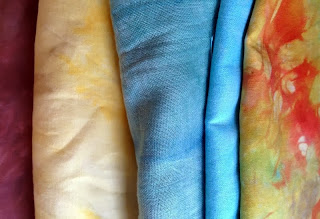 |
| Tray of fabric dyeing |
I’ve been having lots of fun dyeing fabric over the last
week. I don’t tend to follow ‘proper’
recipes and enjoy just messing around to see what effects I can get. Here’s what I’ve been doing.
1. Firstly, I’ve soaked the ‘prepared for dye’ fabric in a
bucket of soda ash solution. For fabric,
I’ve actually been using pure cotton sheets from Asda. They dye nicely and are cost effective, but I
have had problems cutting them neatly afterwards (this may well be me rather
than the sheet...).
 |
| Bottles of dyes ready to be used |
2. In plastic drinks bottles, I’ve mixed the dye with water. I
use Procion Cold Water dyes as no fancy equipment or heat is required. I’ve been using a good teaspoon to almost
500ml (a pint) of water. This bit I do
in the sink with a mask on. The powder
is very fine and will stain and supposedly is carcinogenic (but most things are
if you read the papers and I’m not sure how bad a substance this is, but I try
not to take too many risks).
3. The soaked fabric is then wrung out a bit and placed in a
container. I’ve been using bowls, Tupperware,
cups and solid zip-lock bags. If you
want flat perfect colour, you probably need to read different instructions, but
basically, the fabric needs to be able to float around, not be scrunched up and
I would add the dye before the fabric.
For multi-coloured fun, I put the fabric tightly in the container and
scrunch it up.
 |
| Fabric dyeing in paper cups (they leak!) |
4. Squirt the dye over the fabric. Remember the effects of colour mixing, so don’t
place complementary colours on top of each other unless you want brown. Make sure you use a lot of dye and that it is
soaking down.
 |
| Fabric dyeing in zip-lock bags |
5. After an hour or so, I top up the containers with water with
some salt added to help the fixing process.
Where possible I leave the fabric overnight.
 |
| Washing out the fabric |
6. The next day, I rinse out the fabric in the sink and then
bung in the washing machine with lots of colour catchers and do a light wash to
get rid of any excess dye.
 |
| Using the leftover dye for a paler shade |
7. I then tend to add more fabric to the leftover dye to get
paler shades of what I have already made, which can be quite useful.
 |
| Fabric hanging on the rack to dry. Really I should have started dyeing in summer, not October |
 |
| One proud six year old showing off her fabric |
Now I have lots of fabric, although my daughter has got in
on the act and is secreting away the pieces she thinks are hers for her own
stash, so I don’t have quite as much as I thought!
 |
| Some of the finished fabric, beautifully ironed |
The big question is what to do with all this fabric? I will be using some in my art based work
shortly, but at the moment, I’m just enjoying playing around with it and making
a simple quilt. These are some of the pieces
cut ready for action.
 |
| Fabric cut ready for use |
Dyeing can be a science and very accurate, but I prefer a
looser approach and just seeing what happens.
If I want to use plain fabric, I can buy it, whereas this stuff is more
fun.




2 comments:
Great fun, eh? I like to dye in zip-lock bags so I can see what's inside. I've tended to use a sink to wash rather than my machine (afraid of dye residue) but perhaps I'll give it a try next time out. Love your results!
Oh the joy of discovering all those wonderful happy accidents. This is definitely my sort of dying too although sadly difficult with the septic tank.
Post a Comment